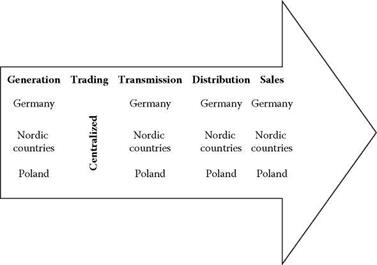In 1909, the Royal Waterfall Board (Vattenfall) was founded to generate electric power from the natural resources of Sweden’s waterfalls.! The company grew rapidly, building coal-fired plants for generating hydropower and developing a unified grid system to connect different parts of the country. By the early 1950s the whole of Sweden was interconnected in a power generation network. In the 1960s, the network spread to neighbouring Scandinavian countries. In the light of increased concerns about overusage of water resources, Vattenfall developed heavy water reactors and subsequently developed light water technology using enriched uranium. Sweden’s first nuclear power reactor became operational in 1972. By the mid-1970s, Vattenfall owned seven of the twelve nuclear reactors in Sweden. However, by the end of that decade political realities saw the scaling back of nuclear energy programmes. In 1992, following the deregulation of the Swedish energy industry, Vattenfall became a public limited company.
Encouraged by EU directives that opened up national energy markets to crossborder competition, Vattenfall successfully pursued commercial opportunities outside Swedish borders. To thrive in this new spirit of competition Vattenfall needed to change its business model and corporate mind-set from one of cooperation to one in which the company was proactively competitive. Vattenfall thus acquired the Finnish network company Hasmeen Sahko and opened an office in the German port of Hamburg. International expansion quickly followed. The number of employees in the company’s operations outside Sweden increased from 10% to 40%. With the creation in 2002 of Vattenfall Europe, 77% of the company’s employees now work outside Sweden. Benefiting from its historical roots in Sweden, Vattenfall traditionally developed its main markets in Scandinavia. Today the company’s market presence in Germany is of equal size and the company is developing its market presence in Poland. Vattenfall (as of December 2006) employs over 32,000 employees, of which 493 people work in energy trading, finance-related activities, and other services shared by the group overall.§ Sales for the year 2006 amounted to €16.1 billion. Sales within Nordic countries were €5.3 billion, sales within Poland were €0.99 billion, and sales within Germany were €7.7 billion. Electricity produced by the [14] [15] [16] [17]
|
FIGURE 8.11 Role of energy trading in the Vattenfall value chain. |
Vattenfall group is sold to 4.9 million customers: 0.9 million in the Nordic countries,
1.1 million in Poland, and 2.9 million in Germany.




